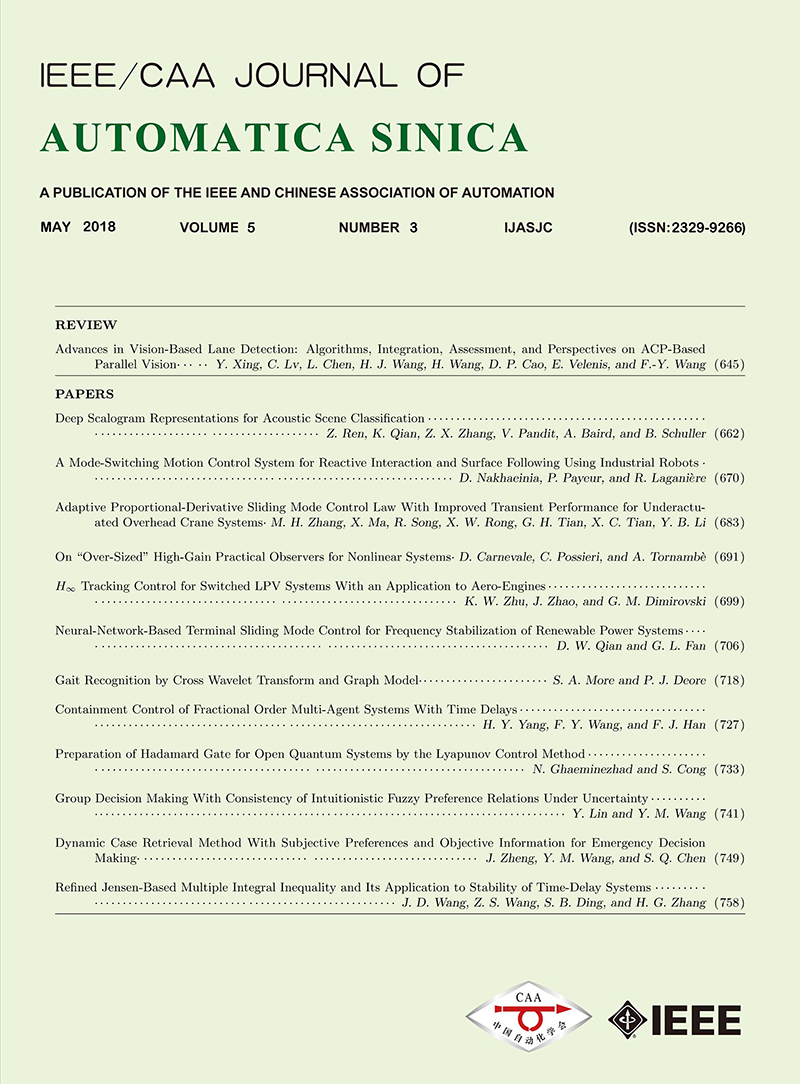 Volume 2
Issue 3
Volume 2
Issue 3
IEEE/CAA Journal of Automatica Sinica
| Citation: | Xiaoyuan Luo, Liu Feng, Jing Yan and Xinping Guan, "Dynamic Coverage with Wireless Sensor and Actor Networks in Underwater Environment," IEEE/CAA J. of Autom. Sinica, vol. 2, no. 3, pp. 274-281, 2015. |

| [1] |
Yan J, Guan X P, Luo X Y, Chen C L. A cooperative pursuit-evasion game in wireless sensor and actor networks. Journal of Parallel and Distributed Computing, 2013, 73(9):1267-1276
|
| [2] |
Chao C M, Wang Y Z, Lu M W. Multiple-rendezvous multichannel MAC protocol design for underwater sensor networks. IEEE Transactions on Systems, Man, and Cybernetics:Systems, 2013, 43(1):128-138
|
| [3] |
Pandey P, Hajimirsadeghi M, Pompili D. Region of feasibility of interference alignment in underwater sensor networks. IEEE Journal of Oceanic Engineering, 2014, 39(1):189-202
|
| [4] |
Wu L H, Li Y P, Su S J, Yan P, Qin Y. Hydrodynamic analysis of AUV underwater docking with a cone-shaped dock under ocean currents. Ocean Engineering, 2014, 85:110-126
|
| [5] |
Smith S L, Schwager M, Rus D. Persistent robotic tasks:monitoring and sweeping in changing environments. IEEE Transactions on Robotics, 2012, 28(2):410-426
|
| [6] |
Smith R N, Schwager M, Smith S L, Jones B H, Rus D, Sukhatme G S. Persistent ocean monitoring with underwater gliders:adapting sampling resolution. Journal of Field Robotics, 2011, 28(5):714-741
|
| [7] |
Huang J J, Sun L J, Wang R C, Huang H P. Improved virtual potential field algorithm based on probability model in three-dimensional directional sensor networks. International Journal of Distributed Sensor Networks, 2012, Article ID 942080
|
| [8] |
Xia Na, Zheng Yu-Chen, Du Hua-Zheng, Xu Chao-Nong, Zheng Rong. Rigidity driven underwater sensor self-organized deployment. Chinese Journal of Computers, 2013, 36(3):494-505(in Chinese)
|
| [9] |
Lee T S, Lee B H. A new hybrid terrain coverage method for underwater robotic exploration. Journal of Marine Science and Technology, 2014, 19(1):75-89
|
| [10] |
Luo X Y, Yan Y L, Li S B, Guan X P. Topology control based on optimally rigid graph in wireless sensor networks. Computer Networks, 2013, 57(4):1037-1047
|
| [11] |
Yan J, Chen C L, Luo X Y, Liang H, Guan X P, Yang X. Topology optimization-based distributed estimation in relay assisted wireless sensor networks. IET Control Theory and Applications, 2014, 8(18):2219-2229
|
| [12] |
Akkaya K, Janapala S. Maximizing connected coverage via controlled actor relocation in wireless sensor and actor networks. Computer Networks, 2008, 52(14):2779-2796
|
| [13] |
Zamanifar A, Sharifi M, Kashefi O. Self actor-actor connectivity restoration in wireless sensor and actor networks. In:Proceedings of the 1st Asian Conference on Intelligent Information and Database Systems. Quang binh, Vietnami:IEEE, 2009. 442-447
|
| [14] |
Pompili D, Melodia T, Akyildiz I F. Three-dimensional and twodimensional deployment analysis for underwater acoustic sensor networks. Ad Hoc Networks, 2009, 7(4):778-790
|
| [15] |
Anderson B D O, Yu C B, Fidan B, Hendrickx J M. Rigid graph control architectures for autonomous formations. IEEE Control Systems Magazine, 2008, 28(6):48-63
|
| [16] |
Eren T, Anderson B D O, Morse A S. Operations on rigid formations of autonomous agents. Communications in Information and Systems, 2004, 3(4):223-258
|
| [17] |
Wang Q, Chen J, Fang H, Ma Q. Flocking control for multi-agent systems with stream-based obstacle avoidance. Transactions of the Institute of Measurement and Control, 2014, 36(3):391-398
|
| [18] |
Arakawa A. Computational design for long-term numerical integration of the equations of fluid motion:two-dimensional incompressible flow. Part I. Journal of Computational Physics, 1966, 1(1):119-143
|
| [19] |
Li Xiao-Lei, Shao Zhi-Jiang, Qian Ji-Xin. An optimizing method based on autonomous animats:fish-swarm algorithm. System Engineering Theory and Practice, 2002, 22(11):32-38(in Chinese)
|
| [20] |
Zhu Z S, So A M-C, Ye Y Y. Universal rigidity:towards accurate and efficient localization of wireless networks. In:Proceedings of the 2010 IEEE INFOCOM. San Diego, CA:IEEE, 2010. 1-9
|